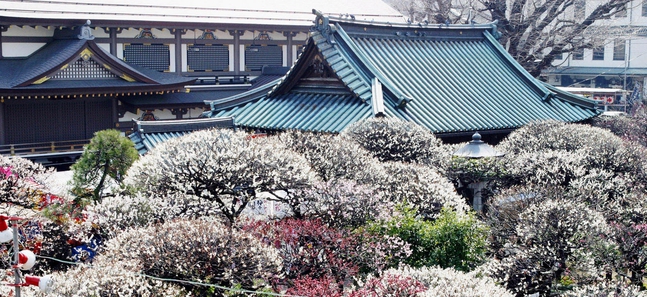
Posted: Fri Jan 30 2015
Plum – or ume – flowers may not be as spectacular as the cherry blossoms, which bloom around a month later and symbolise spring in Japan. Still, these mainly white and pink beauties have been held in high regard for over a millennium, and are renowned for their pleasant fragrance that fills the Tokyo air from early February to mid-March. Plum trees can of course be found all over the city, but the parks, shrines, temples and gardens listed here rank among the top ume-viewing spots, many of which have been popular since the Edo era. Wear your warm jacket and head out to admire these heralds of early spring.
Ushi Tenjin Plum Festival
 Feb 1-25 | Ushi Tenjin Kitano Shrine
Feb 1-25 | Ushi Tenjin Kitano Shrine
Kasuga's Ushi Tenjin shrine is dedicated to the 9th-century scholar and poet Sugawara no Michizane, who is said to have loved the sight of plum flowers. It's thus only fitting that the shrine grounds feature dozens of ume trees, the blooming of which is celebrated at this festival. On Sundays, take the opportunity to taste some plum-flavoured sweets, umeshu liquor and amazake under the purple and white flowers. February 15 sees the highlight of the festival, as the sweets stalls are complemented by outdoor tea service (nodate) and taiko drumming.
Full details
Jindai Plum Festival
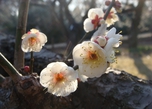 Feb 3-Mar 1 | Jindai Botanical Garden
Feb 3-Mar 1 | Jindai Botanical Garden
The Jindai Botanical Garden's plum park turns pink, purple, and white around the middle of February, when the approximately 180 plum trees burst into bloom. There will be guided tours during the festival period, and visitors can also learn more about Edo-era plum-growing techniques.
Full details
Koishikawa Korakuen Plum Festival
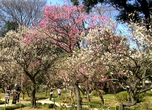 Feb 7-Mar 1 | Koishikawa Korakuen
Feb 7-Mar 1 | Koishikawa Korakuen
Constructed under the watchful eye of 17th century Tokugawa daimyo Mito Komon, Koishikawa Korakuen's plum tree garden remains beautiful to this day. The best time to visit the grounds is in late February, when the trees become filled with purple and white flowers. This yearly festival also features performances of traditional music and Edo-style street artistry.
Full details
Setagaya Ume Matsuri
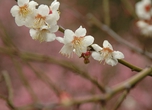 Feb 7-Mar 1 | Hanegi Park
Feb 7-Mar 1 | Hanegi Park
The beautiful flowers of Hanegi Park's over 600 plum trees provide a great excuse for making your way to Umegaoka during this annual festival, which also features stalls selling plum-related (and unrelated) snacks, servings of free matcha tea, koto performances and haiku reading.
Full details
Mukojima Hyakkaen Plum Festival
 Feb 7-Mar 8 | Mukojima Hyakkaen
Feb 7-Mar 8 | Mukojima Hyakkaen
Mukojima Hyakkaen, the only surviving Edo-era flower garden in Tokyo, boasts an impressive collection of ume trees that bloom beautifully in early spring. This festival takes place to celebrate the colourful scenery and features performances of traditional arts and dances, including the Sendai-born suzume odori ('sparrow dance').
Full details
Keio Mogusaen Plum Festival
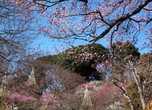 Feb 7-Mar 15 | Keio Mogusaen
Feb 7-Mar 15 | Keio Mogusaen
Boasting a total of 500 plum trees, some of them more than 300 years old, Hino's Mogusaen has long been famed as one of Tokyo's best ume-viewing spots. A variety of traditional events take place on the weekends during this festival, while the Shorenan teahouse on the premises stays open throughout, serving treats like plum sorbet and amazake ice cream.
Full details
Bunkyo Ume Matsuri
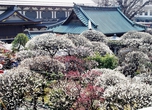 Feb 8-Mar 8 | Yushima Tenjin
Feb 8-Mar 8 | Yushima Tenjin
Yushima Tenjin shrine has been a popular spot for plum blossom lovers since the Edo period, and crowds still flock there each year to see its 300-odd ume trees in full bloom. The shrine's annual Ume Matsuri hits its peak towards the end of February and is busiest on the weekends, when the natural splendour is complemented with displays of traditional Japanese music and performing arts – plus the added option of tea ceremony.
Full details
Koganei Park Ume Matsuri
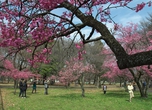 Feb 14-22 | Koganei Park
Feb 14-22 | Koganei Park
Enjoy the Musashino spring at Koganei Park, where around 100 plum trees will burst into bloom in February. Volunteers will be on hand to guide visitors around the park, and there will also be performances of traditional Japanese music at a temporary stage set up under the trees. Open-air tea ceremony is available for ¥500.
Full details
Sankeien Plum-Viewing
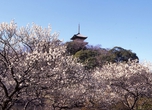 Feb 14-Mar 8 | Sankeien
Feb 14-Mar 8 | Sankeien
Although best known for its cherry blossoms, Yokohama's spacious Sankeien is also a nice choice for plum-watching. Bursting into white and pink from February to March, the around 600 trees here include a few rare varieties. Mochi pounding, performances of traditional music and free barley tea (at the park's teahouse) add to the experience.
Full details
Kameido Ten Jinja Plum Festival
 Feb 14-Mar 15 | Kameido Ten Jinja
Feb 14-Mar 15 | Kameido Ten Jinja
Kameido's charming Tenjin Shrine hosts this annual early spring festival in celebration of the 300 plum trees on the premises. The flowers usually reach full bloom between the middle of February and early March, while a variety of events will take place throughout the festival period.
Full details
Shiba Koen Plum Festival
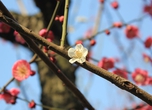 Feb 20, 21 | Shiba Park
Feb 20, 21 | Shiba Park
The around 70 purple and white plum trees at Shiba Park were actually transplanted from Shinjuku's Tsunohazu in the early 1900s. This festival celebrates their blooming with performances of traditional Japanese music and a tea ceremony. Note the admission limit of 350 people (first-come, first-served).
Full details
Mt Takao Plum Festival
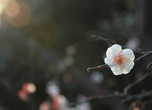 Mar 14, 15 | Around Mt Takao
Mar 14, 15 | Around Mt Takao
The woods on the north side of Mt Takao and along the old Koshu-kaido highway are home to almost 10,000 plum trees. That entire area turns white and purple in March when the flowers start blooming, and this festival celebrates the occasion with performances of traditional Japanese music, sales of plum-related items and loads of great festival food.
Full details
Tags:
Tweets
- About Us |
- Work for Time Out |
- Send us info |
- Advertising |
- Mobile edition |
- Terms & Conditions |
- Privacy policy |
- Contact Us
Copyright © 2014 Time Out Tokyo














Add your comment